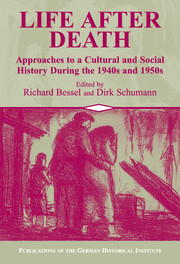Book contents
- Frontmatter
- Introduction Violence, Normality, and the Construction of Postwar Europe
- 1 Post-Traumatic Stress Disorder and World War II
- 2 Between Pain and Silence
- 3 Paths of Normalization after the Persecution of the Jews
- 4 Trauma, Memory, and Motherhood
- 5 Memory and the Narrative of Rape in Budapest and Vienna in 1945
- 6 “Going Home”
- 7 Desperately Seeking Normality
- 8 Family Life and “Normality” in Postwar British Culture
- 9 Continuities and Discontinuities of Consumer Mentality in West Germany in the 1950s
- 10 “Strengthened and Purified Through Ordeal by Fire”
- 11 The Nationalization of Victimhood
- 12 Italy after Fascism
- 13 The Politics of Post-Fascist Aesthetics
- 14 Dissonance, Normality, and the Historical Method
- Index
Introduction - Violence, Normality, and the Construction of Postwar Europe
Published online by Cambridge University Press: 05 January 2013
- Frontmatter
- Introduction Violence, Normality, and the Construction of Postwar Europe
- 1 Post-Traumatic Stress Disorder and World War II
- 2 Between Pain and Silence
- 3 Paths of Normalization after the Persecution of the Jews
- 4 Trauma, Memory, and Motherhood
- 5 Memory and the Narrative of Rape in Budapest and Vienna in 1945
- 6 “Going Home”
- 7 Desperately Seeking Normality
- 8 Family Life and “Normality” in Postwar British Culture
- 9 Continuities and Discontinuities of Consumer Mentality in West Germany in the 1950s
- 10 “Strengthened and Purified Through Ordeal by Fire”
- 11 The Nationalization of Victimhood
- 12 Italy after Fascism
- 13 The Politics of Post-Fascist Aesthetics
- 14 Dissonance, Normality, and the Historical Method
- Index
Summary
Works of fiction often express things better than do works of history. At the outset of his remarkably perceptive novel, Home Fires: An Intimate Portrait of One Middle-Class Family in Postwar America, Donald Katz writes of his protagonist in 1945:
Sam Goldenberg came back from the war, and now that he had broken the ice with Eve he was able to say that there was only one thing he wanted from the rest of his life: a normal family. That was all a million other guys who'd survived the family degradations of the Depression and the harrowing experiences of the war wanted too.
Hardly a surprising reaction to the horrors of war, and obviously it is a considerable leap from (Jewish) middle-class America to a devastated European continent after the destruction of the “Third Reich.” However, this pithy statement points to a major, perhaps the major, social and psychological turning point of our century.
The history of the twentieth century revolves around mass death. At its center lies the mass killing and mass murder carried out during the decade roughly from the late 1930s to the late 1940s - during which time more people were killed by their fellow human beings than ever before in the history of humankind. Against the terrible dimensions of the mass death of that decade, the hitherto unimaginable horrors of the First World War and its immediate aftermath appear as merely an antechamber to the house of horrors that arose two decades later.
- Type
- Chapter
- Information
- Life after DeathApproaches to a Cultural and Social History of Europe During the 1940s and 1950s, pp. 1 - 14Publisher: Cambridge University PressPrint publication year: 2003
- 1
- Cited by



